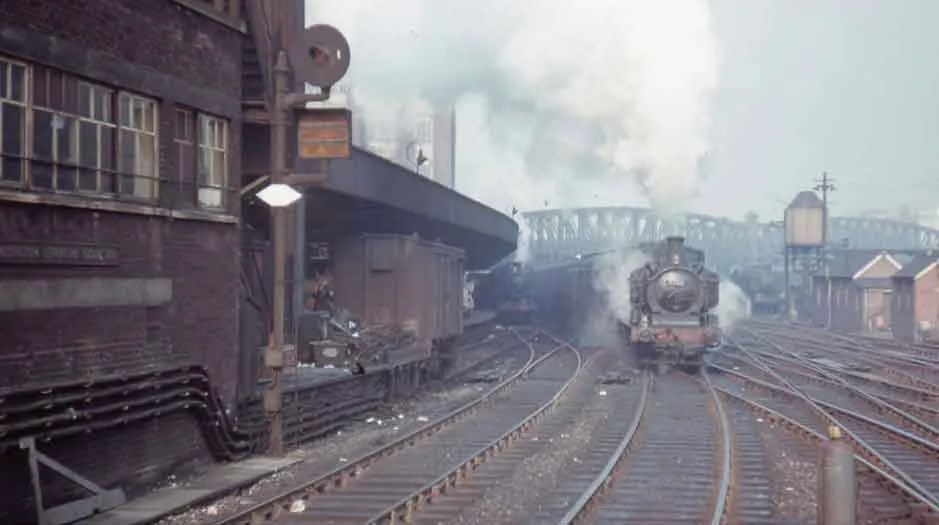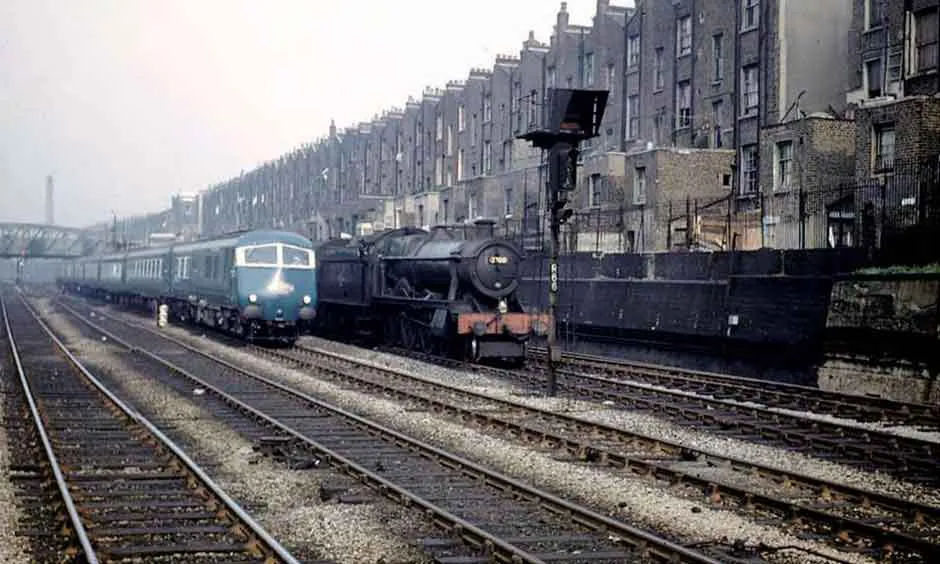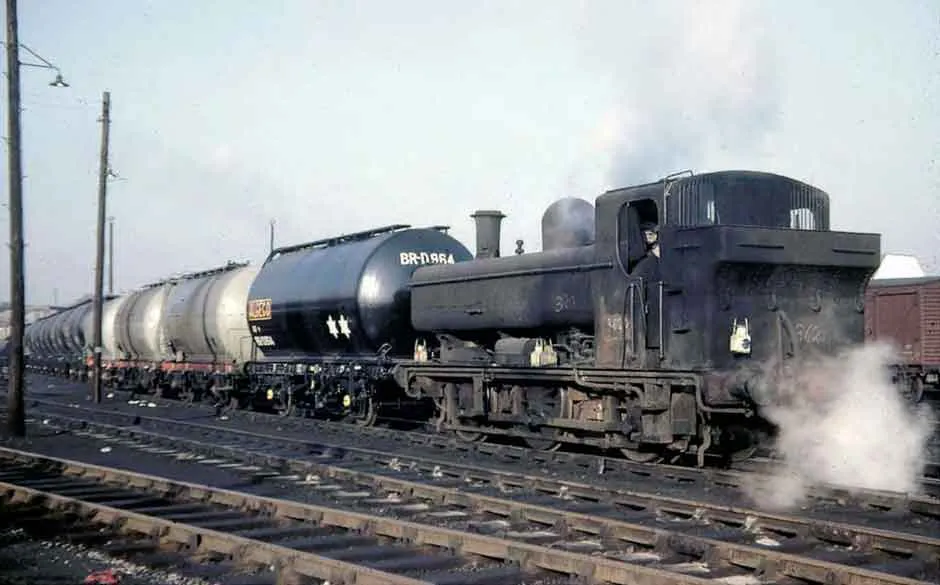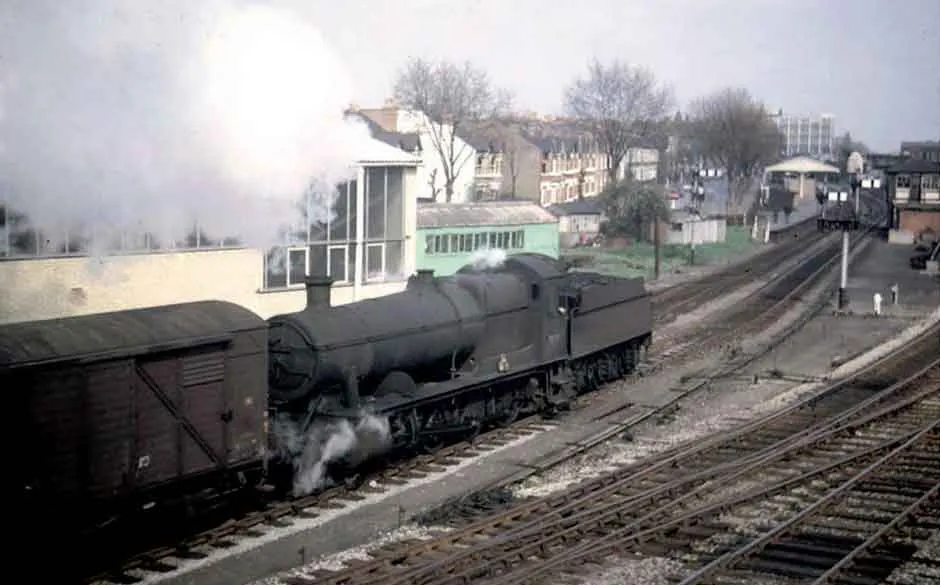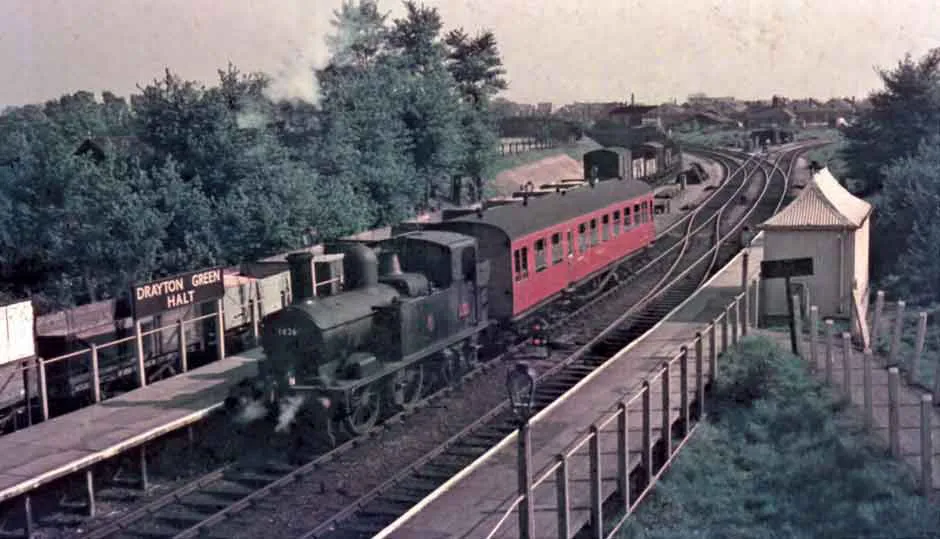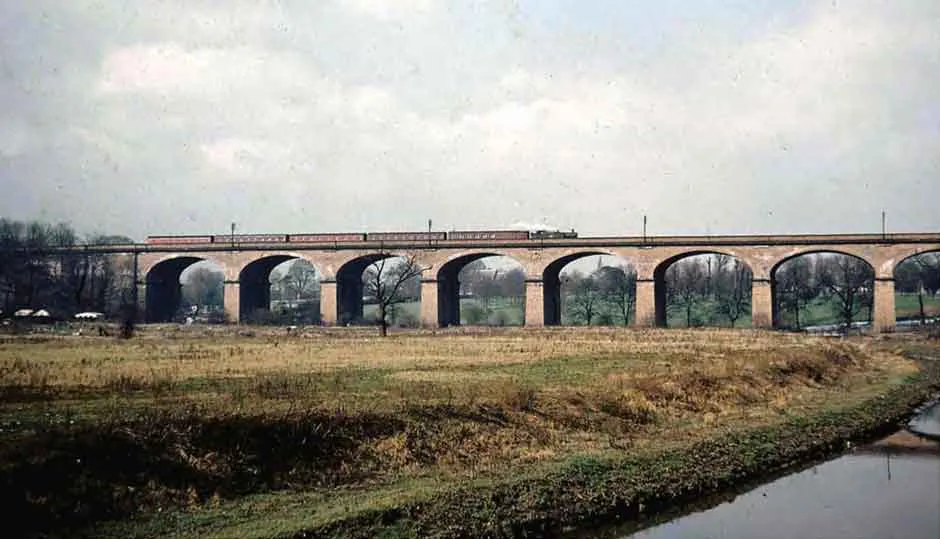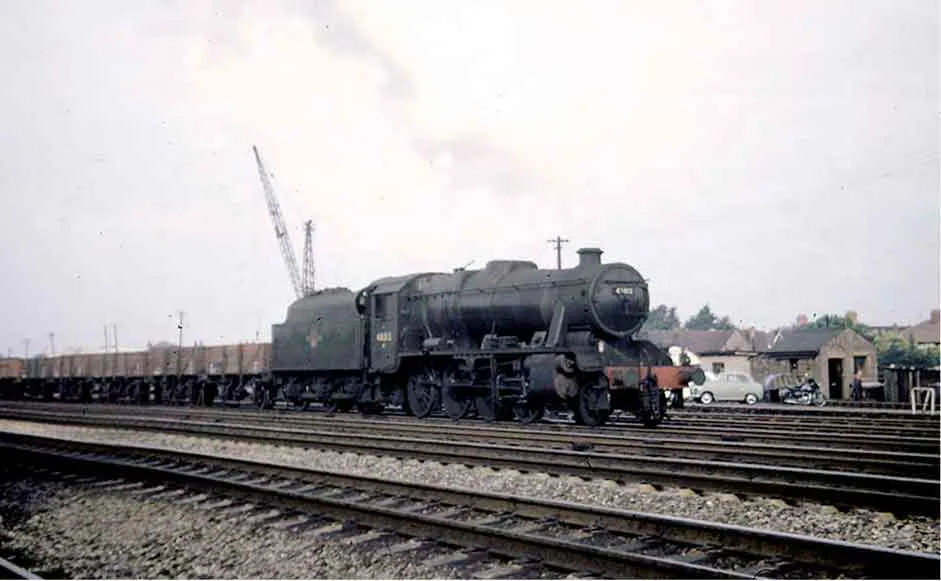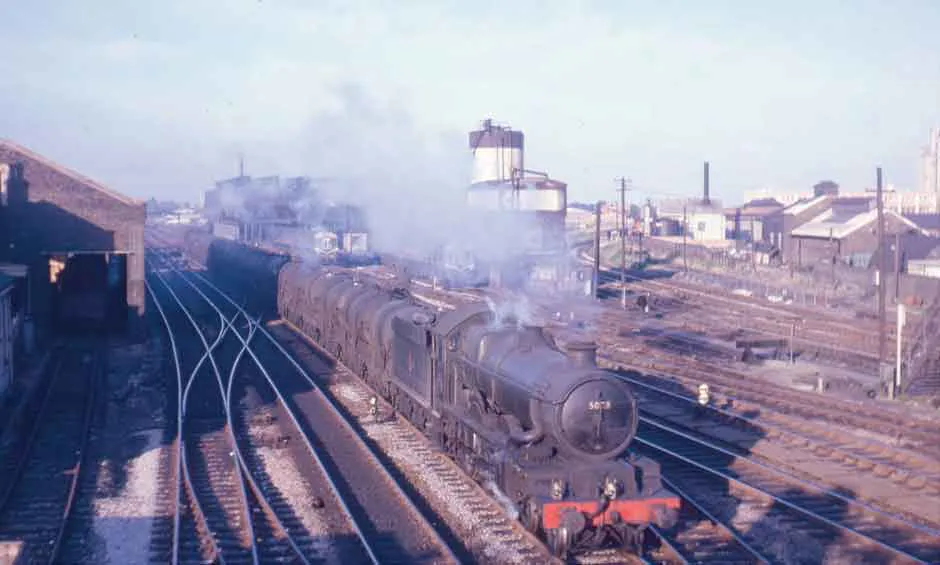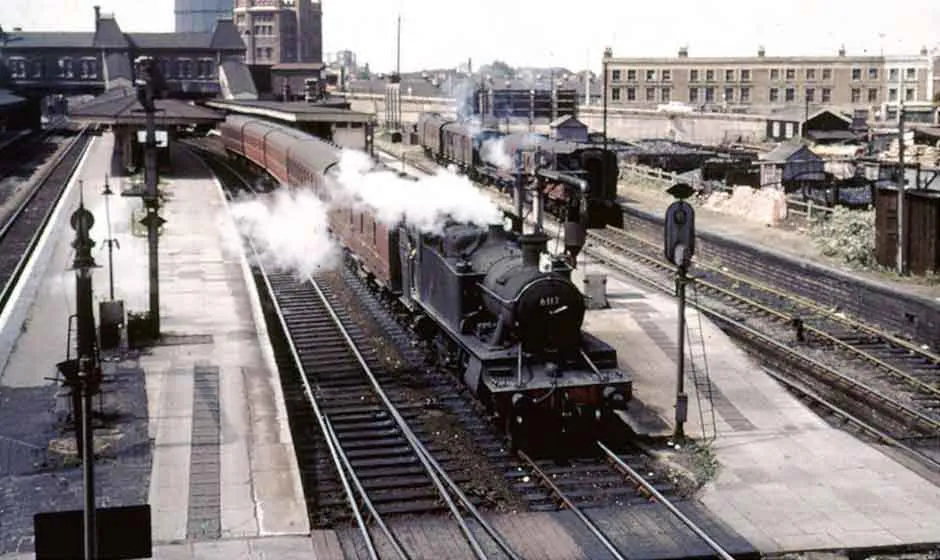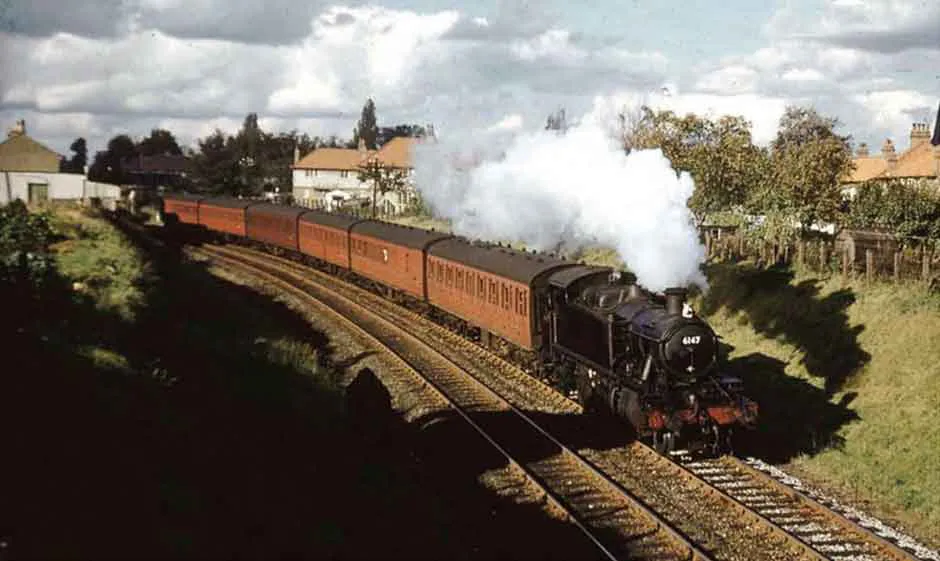![]()
Starting with the WR, empty stock movements between Old Oak Common carriage sidings and Paddington were usually worked by various types of pannier tank, such as Collett condensing tank No 9700. This is seen entering Paddington station on 15 April 1961, flanked by two distant Hawksworth heavy pannier tanks. No 9700 was designed to take freight trains to the GWR’s goods depot beneath Smithfield (meat) Market, some three miles east of Paddington. Access was via the Met’s Underground lines, requiring GWR locomotives to be fitted with condensing apparatus for working through the tunnels. By the early 1930s the existing locomotives used on these freights were wearing out and No 9700 became the guinea pig for a replacement type. Built by Beyer Peacock, this engine entered service as No 8700 in February 1931. In March 1932 it was converted into a condensing locomotive, spawning a further ten such pannier tanks, Nos 9701-9710, constructed at Swindon in 1933, and No 8700 was then renumbered in January 1934. (Alan Sainty collection)
One of the WR’s Blue Pullman diesel sets passes stock hauled by Modified Hall 4-6-0 No 7900 Saint Peter’s Hall near Royal Oak, on the outskirts of Paddington, in 1961. By this time, there were three blue Pullman services, the Birmingham Pullman, the Bristol Pullman and the South Wales Pullman, the first two trains having been introduced on 12 September 1960. The Pullmans were certainly visually attractive but were not very reliable, being underpowered and with a tendency towards rough riding. They were withdrawn by 1973 but left behind an important legacy, influencing the design of the highly successful Inter City 125s which are still operating today. As regards the role being performed here by No 7900, this is unclear as it is carrying a headlamp in the position for shunting, an unlikely activity in this particular location. (Harry Luff/Online Transport Archive)
Old Oak Common was the depot serving Paddington but, in addition to having an allocation of express locomotives, it also housed more menial classes for general duties. One such engine, pannier tank No 3620, stands alongside the shed in January 1965 at the head of a train of oil tank wagons, evidence of the advancing dieselisation programme. The locomotive is in typically unkempt condition for this final year of WR steam, its number chalked on in several places following removal of its cabside number plate. Unauthorised access to the depot in steam days was often achieved by finding a hole in the fence along the towpath of the nearby canal! (Author)
Another unkempt locomotive typifying the decline of WR steam, 2-8-0 No 3851 brings a freight train off the Greenford Loop and towards West Ealing Station (seen in the background) in March 1965. The picture was taken from “Jacob’s Ladder”, the footbridge where the author spent much of his misspent youth trainspotting! The 2884 class to which No 3851 belonged was Collett’s development of Churchward’s earlier 28XX class (Nos 2800-2883), designed for heavy freight work. Several examples of both types are preserved, all but one having ended up in Dai Woodham’s rest home for redundant engines (aka Barry Scrapyard) and subsequently extracted. (Author)
Playing Cowboys and Indians in the fields between Castlebar Park Halt and Drayton Green Halt on the Greenford branch in the 1950s was a regular pastime for the author, interrupted by the steam push and pull passing by, hauled by a diminutive 14XX 0-4-2 tank or a more powerful 54XX pannier tank. However, pleasure turned to pain on 25 August 1958 when diesels took over this Ealing Broadway - Greenford service (now Paddington - Greenford). The line had opened in 1903 to enable a circular service to and from Paddington to be operated for the Royal Agricultural Show located on land at Twyford Abbey (the district subsequently being called Park Royal). Normal branch services started in 1904. Shortly before the end of steam operation, No 1426 waits at Drayton Green Halt before propelling its auto trailer (W220 Thrush) around the east curve to West Ealing station. Note the red cabside numberplate, a short-lived fad. (Julian Thompson/Online Transport Archive)
Until DMUs started to displace steam hauled compartment stock in the late 1950s, most of the WR suburban trains into and out of Paddington were hauled by the powerful 61XX 2-6-2 tanks which replaced the similar looking County 4-4-2 tanks in the early 1930s. This winter 1957/8 view looking north depicts a green-liveried “tanner-oner” (as we loco spotters called the class) on an up local to Paddington crossing Brunel’s splendid Wharncliffe Viaduct over the Brent Valley at Hanwell. Dating from 1836/7, the viaduct was Brunel’s first major structural design and was named after the chairman of the parliamentary committee that steered the GWR bill through Parliament and whose coat of arms are visible on the brickwork below the engine’s bunker. Although the viaduct now carries overhead electrification support columns, these have been sympathetically sited so that they are scarcely any more obtrusive than the previous telegraph poles. (Julian Thompson/Online Transport Archive)
In the final year of WR steam, LMR locomotives became increasingly evident in the London area on freight work. Looking comparatively smart for the time (August 1965) Stanier 8F No 48012, dating from 1936, is approaching Southall engine shed with a westbound goods. Sir Willliam A Stanier started his railway service with the GWR before moving to the LMS and it is hardly surprising therefore that his designs have a look of the GWR about them. On the other hand, Hawksworth’s County 4-6-0s were fitted with boilers which had much in common with the Stanier 8Fs, Hawksworth seemingly taking more than a passing interest in the batch of 8Fs being built by the GWR at Swindon Works during the Second World War. (Author)
Viewed from the footbridge where the seeds of the Great Western Society were first sown by four local schoolboys, Castle class 4-6-0 No 5023 Brecon Castle brings Whitland-bound milk empties past Southall shed on 10 July 1962. Milk traffic to London from the West Country and South Wales provided the WR with lucrative business and express locomotives of the Castle or King classes were normally provided for what were regarded by the GWR and WR as prestigious services. No 5023 was built in 1934 and withdrawn in February 1963, some six months after this photograph was taken. The locomotive was scrapped but eight members of the 171-strong class have been preserved. (Alan Sainty collection)
Looking westwards from Southall footbridge, 2-6-2 tank No 6117 stands at Southall station with a Paddington-bound local in 1959. The railway line from Paddington to Maidenhead Bridge (Taplow) opened in 1838 but it was almost another year before Southall station was built. Much of the background behind the train remains today: the right hand portion of the station building, the gas holder (dating from 1932) and the castellated brick water tower built in 1903 and now converted into apartments. However, this scene can be expected to alter significantly as a result of Crossrail which will burrow under central London, linking Maidenhead (or possibly even Reading) and Heathrow in the west to Shenfield and Abbey Wood in the east. (Julian Thompson/Online Transport Archive)
Recently arrived from the West Country following dieselisation, light Prairie tank No 5531 was one of a small batch of these locomotives allocated to Southall depot in 1964, bringing some welcome variety to the somewhat uninspiring stud of 61XX large Prairie tanks and pannier tanks which epitomised this largely freight shed. In this view dating from December 1964, No 5531 is about to haul a freight train from West Drayton sidings adjacent to the Coal Depot opened in 1963 which its owners, the National Coal Board, claimed to be the largest mechanical depot for handling household coal in Europe. (Author)
Ex-GWR prairie tank No 6147 departs from Cowley with a stopping train to Paddington from Uxbridge Vine Street in summer 1957. The normal WR 5-carriage suburban set has been strengthened with an additional coach behind the engine. Until 1939, the town of Uxbridge boasted three railway stations serving different lines, the first to close being the branch from the Birmingham main line to Uxbridge High Street which was meant to join up with the Uxbridge Vine Street/West Drayton branch but the connection building works were never completed. Neither line was able to compete successfully with the ...

